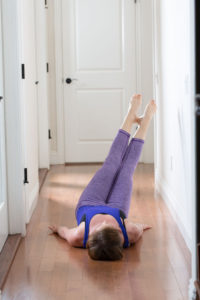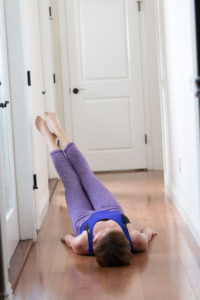The freedom, peace, and energy that I experience in my body through Pilates, I also find in mountain vistas. While shaping, controlling, and physically training my mind has allowed me to find beauty in everyday Los Angeles, given the chance to skip town and head for the peaks, I will gladly trade in my reformer for a slope to climb up or ride down. For this reason, I appreciate the opportunity to include sequences in my regular practice that support my passion. Pilates for snowboarders is a powerful set of exercises that build the strength necessary for a successful day on the slopes.
When I snowboard, I always appreciate the time I put into my Pilates training. I benefit from balance, posture and stability, as well as rotational core strength and lower limb strength and agility. Although we can perform some Pilates exercises with a magic circle, in essence giving ourselves a tool that mimics the activity of the board; not everything can be simulated. There is no sliding in Pilates (other than on your own sweat on the mat) and there are no slopes. Even so, the awareness gained through Pilates training can prepare you better for how you are going to adapt to those variables once you get a feel for the snow and the slope.
Here are some Pilates moves that can prepare you for snowboarding:
- For Balance and Lower Body Agility and Strength– Wall Squats (with two legs and then one legged)
Stand with your back to a wall and your feet about 18 inches in front of the wall. Draw your navel in and up. Slide your back down the wall until your bottom is just higher than the level of your knees. Count slowly to 15. Push your feet down in the floor-boards and draw your navel in and up to slide back up the wall. Repeat two more times. Then try to replace one foot down your midline and extend the other leg 30 degrees forward. Repeat three times on each leg. Try not to change the position of your pelvis as you slide up and down the wall; keep it in the same orientation whether your legs are bent or straight. Try to keep as many parts of your back touching the wall as you can without strain.
- For Posture– Wall Rolls–Once you are back to a standing position, place your heels together. Again, draw your navel in and up. Feel the opposition of your feet down into the floor while your abdomen lifts your trunk tall to the sky. This opposition will give you the ability to feel your control down into the snowboard, while staying buoyant and flexible on top: this is your two-way stretch. Roll your spine down, bone-by-bone, off the wall until your face is even with your pelvis. Find your two-way stretch and roll back up. Continue to work on this until you can keep your feet less than two inches from the wall and can roll down and up without losing balance.
- Stability– Leg Pull– Now go to a mat and take a plank position (phalakasana). Place the hands under the shoulders and tuck the toes under on the mat. With shoulders down, a hollow abdomen and heels lifted, raise one leg in the air. Sustain this position for 10 counts. Slowly flex the foot of the supporting side. Use the two-way stretch described above. Resist lifting the heel and return the other foot to the floor. Repeat three times on each side. Avoid flexing your hips when you lift the leg, the leg lift works the bottom and stretches the front of the hip, helpful for keeping you lined up over your board and a strong center.
- For Abdominal strength and mobility–The 4-Corner Corkscrew–This exercise can be done holding a yoga block or magic circle between your ankles or even an exercise band tied around the outside of the ankles with pressure placed out on the band. Lay down on your back on a mat. Press into a candle pose/sarvangasana) with arms on the mat. Looking at your toes, imagine you are in the middle of a four poster bed. Engage your glutes and squeeze the heels toward each other. Start to roll down the spine towards the mat. When you feel your ribs touch the mat, reach both legs together as if you want to touch the poster over your right shoulder, then lower right, lower left, and left shoulder and rise back up to candle. Repeat to the other side. Repeat four times to each side. You can practice variations, repeat it slow, fast, with something between the ankles, a medicine ball, et cetera. Just hold your navel to your spine and use the two-way stretch.
- For lower limb agility– The 2 by 4. Yep, if you have a 2 by 4 use it. Or you may do this off a step. Stand with your heels together and toes apart. Recall again holding your navel to your spine and the two-way stretch from above and how tall you stood against the wall. In four actions: (1) Bend the knees, (2) roll up on the toes (3) straighten the legs, and (4) lower the heels; imagine the 2 by 4 is your snowboard and the goal is to keep your shoulders over is through all the motions. Repeat three times in slow motion and three times quickly. Reverse the motions with the same dynamics and increase your range. Using your heels and toes to feel the slope is important. Here you can feel how placing your weight on different part of your lower legs feels so you can manipulate the board better to your needs.
I hope each of you trades in your urban exercise for a mountain vista at least once this year. Incorporate Pilates into your training and take these exercises with you for a warm-up. The balance, posture, stability, core and lower body agility that Pilates introduces you to will open your mind to ways to maneuver your weight on the slope and will give you more control.
Take in the mountain beauty and bring it back in your mind to your studios, gyms, and your study.
Read Kara Wily’s suggestions for integrating Pilates and Yoga practice.
Kara Wily is a Pilates teacher at Hummingbird Pilates in Beverly Hills (hummingbirdpilates.com). She is also a contributor to pilatesology.com and PilatesAnytimes.com.



